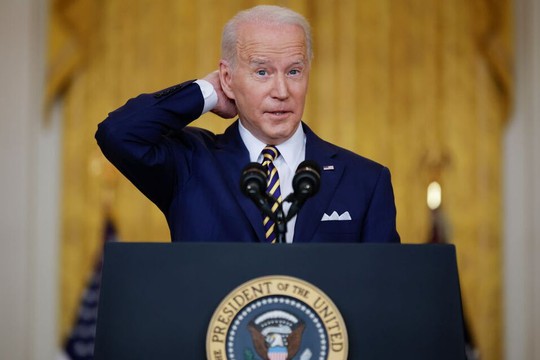President Biden.
Photo: AP
It has now been over a year and a half since Kyiv made any substantial gains on the battlefield. As political scientist Graham Allison recently pointed out, Russia took more territory in the past two months than Ukraine liberated in its entire 2023 counteroffensive.
In this moment of crisis, the U.S. has chosen a Goldilocks approach. American officials have long opposed Ukrainian strikes on Russian territory, in part due to fears of escalation and in part due to the potential impact on global oil prices. But Secretary of State Antony Blinken appeared to soften that stance in comments last week.
“We have not encouraged or enabled strikes outside of Ukraine, but ultimately Ukraine needs to make decisions for itself on how it conducts this war,” Blinken said. “We will continue to back Ukraine with the equipment it needs to win.”
From Ukraine’s perspective, such comments are far too ambiguous. But American actions have been somewhat more direct. Just a few weeks ago, Washington revealed that it had secretly given long-range missiles to Kyiv that are capable of striking deep within Russian territory, notes ‘The Responsible Statecraft’.
The U.S. has been firmer in its opposition to sending troops to Ukraine or directly helping to shoot down Russian missiles. While some NATO states have warmed to the idea of deploying soldiers to the country, Gen. C.Q. Brown, the chairman of the Joint Chiefs of Staff, said that “right now, there are no plans to bring U.S. trainers into Ukraine.”
As Zelensky plays down fears of nuclear escalation, the Kremlin is taking a different tack. Russian President Vladimir Putin ordered drills this week in which his troops practiced using tactical nukes. While these battlefield weapons are smaller than strategic warheads, certain variants can pack a bigger punch than the bombs that flattened Hiroshima and Nagasaki in 1945.
Russia said the drills, which took place near the border with Ukraine, were a response to “provocative statements and threats of certain Western officials regarding the Russian Federation.”
The escalatory move highlights a diplomatic tension that the Biden administration has yet to address. Washington’s superseding goal is to prevent nuclear escalation by avoiding a direct conflict with Moscow. Ukraine, for its part, has every reason to drag the U.S. into a war that Kyiv views as existential.
European states are stuck in the squishy middle. Europe has stronger incentives to back Ukraine to the hilt, hence why countries like France and Britain have floated plans for more direct involvement in the war. But any sudden move would naturally implicate their most powerful ally, the United States, which has strongly discouraged any efforts to drag NATO into the conflict.
The West has largely papered over these divisions by insisting that it will continue to back Ukraine “as long as it takes.” But, as Kyiv’s battlefield position worsens, that approach could have an expiration date.

NATO Secretary-General Jens Stoltenberg is facing calls for his resignation after arguing that Ukraine should be given dispensation to use supposedly defensive Western-supplied missiles to attack targets in the Russian mainland, Breitbart informs.
With Moscow continuing to make territorial advances as the war in Ukraine grinds on, Stoltenberg argued over the weekend that one reason for the disparity in battlefield success is that Kyiv is prohibited from using NATO-supplied missiles and other weapons to attack targets within Russia.
“To deny Ukraine the possibility of using these weapons against legitimate military targets on Russian territory makes it very hard for them to defend themselves,” the NATO chief said.
While European powers have backed Ukraine in defending itself within its own UN-recognised borders — and therefore use Western money and weapons to fight Russian soldiers within Ukraine — there has been little appetite to appear to be directly attacking Russia.
The escalatory suggestion from Stoltenberg sparked outrage from Rome, with Deputy Prime Minister Matteo Salvini saying that the NATO chief should either “retract, apologize, or resign,” public broadcaster RIA reports. Salvini said that Italian military aid to Ukraine was supplied strictly for defensive purposes, not for “fighting, striking and killing outside its territory”.
“NATO cannot force us to kill in Russia, nor can anyone force us to send Italian soldiers to fight or die in Ukraine,” he said.
Although broadly supportive of the war effort in Ukraine, Italy, has of late become a leading voice for moderation within Europe, for example expressly rejecting suggestions from French President Emmanuel Macron that NATO troops may need to be sent into the battlefield to prevent an outright victory for Moscow.
Prime Minister Giorgia Meloni, continued to say that there have been “many questionable statements,” highlighting those made by President Macron, concluding: “I recommend more caution.”
read more in our Telegram-channel https://t.me/The_International_Affairs

 9:45 02.06.2024 •
9:45 02.06.2024 •























